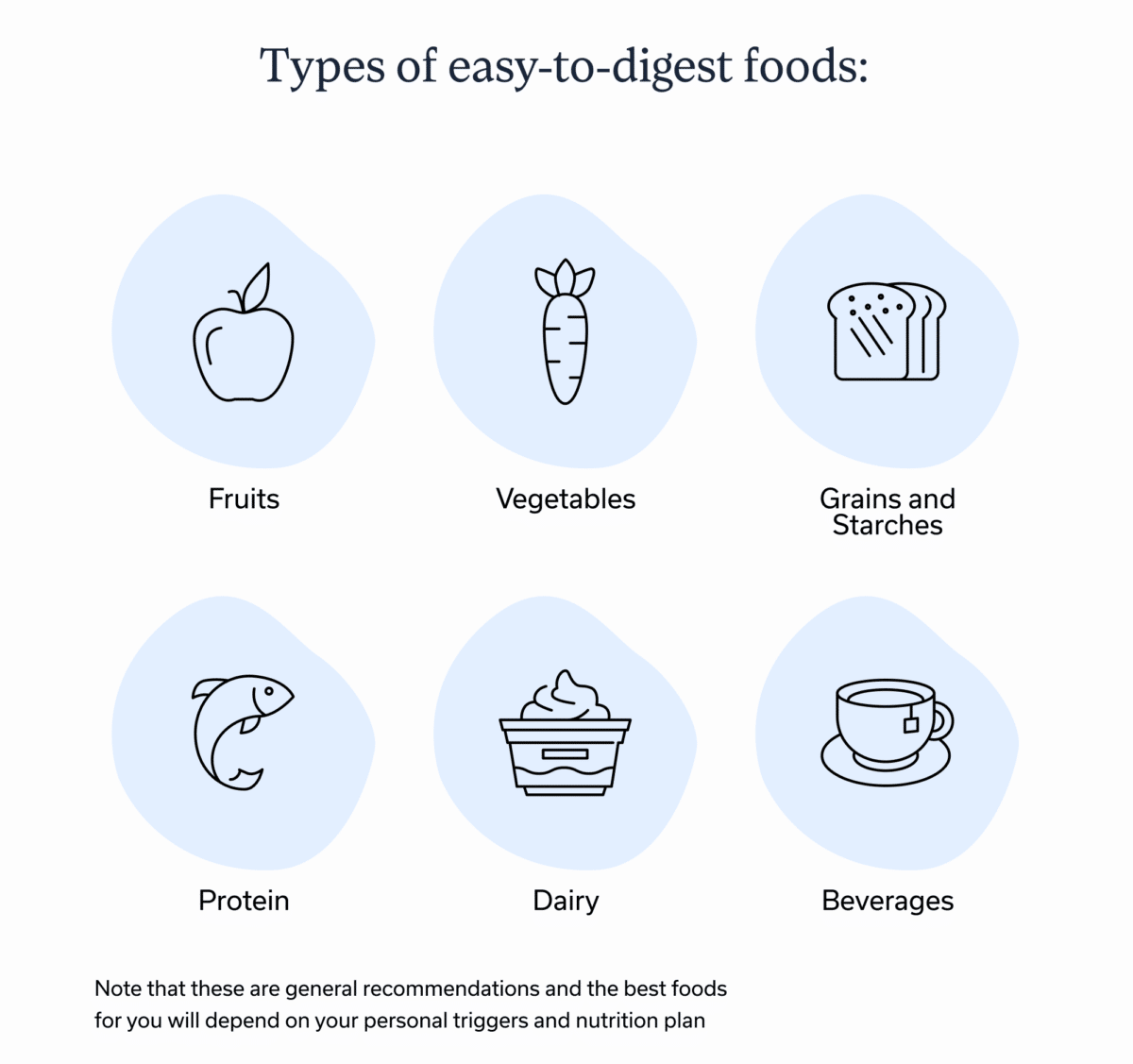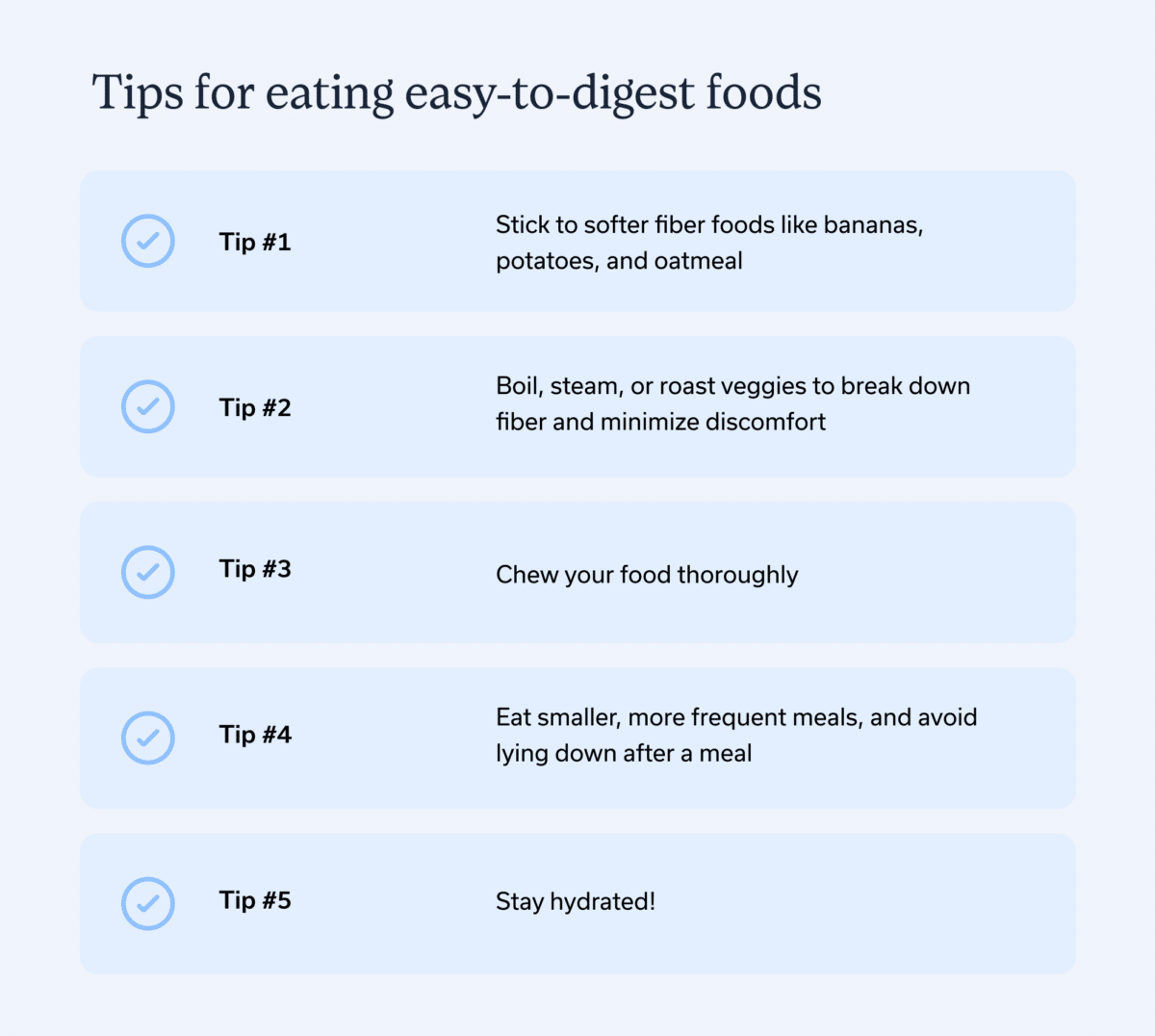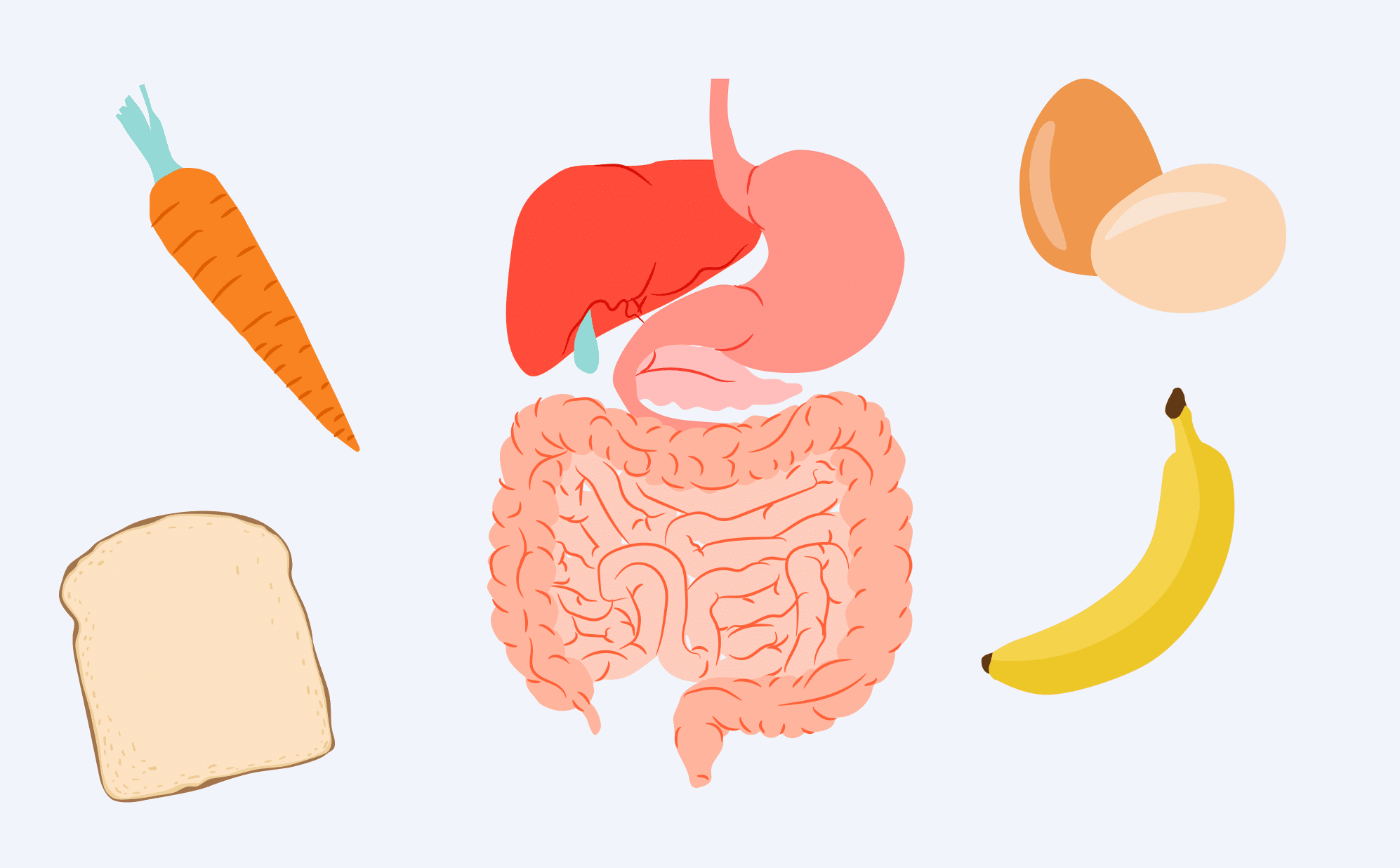Whether you’re recovering from a stomach bug, experiencing a flare of a gastrointestinal (GI) condition, or dealing with GI symptoms, you may need to temporarily eat a diet of easy-to-digest foods and drinks. Bananas, white rice, crackers, and broth are common go-to foods when managing stomach troubles. But other foods are widely known as no-gos for those with sensitive stomachs. A certain level of experimentation is warranted to find the specific foods that play best with your GI tract, rather than taking a one-size-fits all approach.
“I don’t think my stomach can handle that,” I sometimes say when my husband is weighing the evening’s dinner options. If I’m experiencing an irritable bowel syndrome (IBS) flare, I’ll lean on easy-to-digest foods, rather than some of my spicier or more fiber-rich favorites, to get me through the rough patch—because, hey, a girl’s gotta eat.
“When experiencing a GI flare-up or temporary digestive discomfort,” says Chelsea McCallum, an accredited practicing dietitian in Brisbane, Australia, “eating foods that are gentle on the gut can help reduce symptoms like bloating, pain, and diarrhea while still providing essential nutrients for recovery.”
Sometimes I’m tempted to forgo eating altogether when my gastrointestinal (GI) tract is unhappy, but as McCallum adds, “Maintaining a balanced diet during these times also supports gut microbiome resilience, which is important for long-term digestive health.”
This is where foods that are easy on the stomach come in. By choosing foods your digestive tract can easily break down, you can reduce or even prevent uncomfortable GI symptoms. That said, the supposedly “easily digestible” foods that work best for one person may not work as well (or at all) for you, so a little trial and error may be necessary. We’ve created a list below that gives you some ideas.
Whether you’re hoping to manage a flare with some short term dietary adjustments, or looking for a longer term diet to manage a lifelong condition, working with a GI registered dietitian can be a tremendous help in crafting a diet plan that meets your needs.They’ll consider your food preferences (including cultural favorites), any intolerances, and your unique GI symptoms. Plus, they can create a comprehensive plan that ensures you’ll stay well nourished.
When you might need easy-to-digest foods
My diet during a flare is vastly different from my diet when I’m living relatively symptom-free. But an IBS flare is just one reason you might need to switch things up. Here are some others.
Common situations requiring easily digestible foods
Experiencing digestive discomfort
You may temporarily need to take your diet from adventurous to much more chill if you’re experiencing GI symptoms, such as bloating, constipation, diarrhea, acid reflux, and more.
Managing a GI condition
If you have IBS, gastroesophageal reflux disease (GERD), acid reflux, inflammatory bowel disease (IBD), or another GI condition, you may need to switch to an easy-to-digest diet. Some people may need a personalized regular diet as well as a diet that’s even easier to digest during a symptom flare.
Recovery from Crohn’s or colitis surgery
A GI-related surgery and many other types of procedures often warrant a gentler diet for a few days—or longer. Of course, you should always follow your doctor’s recommendations for recovery.
Recovery from general illness
And anyone who has ever had the common cold, flu, or other infection knows that your appetite can change during illness and leave you leaning on some blander basics in your pantry or fridge.
Types of easy-to-digest foods
The following foods tend to be easy on the GI tract. But if you know that any of these are a trigger for you, then feel free to leave them out of your next grocery haul. Again, a GI registered dietitian can be a great help in figuring out which foods will be best for you.

1. Fruits
Bananas. Bananas contain potassium, a crucial electrolyte. This means they generally don’t contribute to bloating or discomfort. This yellow fruit is a go-to for me when my GI tract is feeling blah. Bonus points for portability.
Blueberries. Blueberries are anti-inflammatory and high in fiber and water content, which makes them a strong contender for an easy-to-digest diet. They make a great snack on their own or as an addition to yogurt, oatmeal, or a smoothie. However, because of their fiber content, they could exacerbate diarrhea if that’s one of your symptoms.
Melons. Melons are soft and have a high water content, which aids with hydration. They can help you keep your fiber,vitamin, and mineral intake up while minimizing potential GI discomfort.
2. Vegetables
Carrots. These root vegetables contain antioxidant compounds called carotenoids, which may protect against digestive diseases. Cooking, roasting, or steaming carrots will make them easier to digest. Eat them as a side, puree them into a soup, or add them to a main dish to boost its flavor and fiber.
Parsnips. Parsnips, another root veggie, have a distinct nutty flavor, perfect for enhancing stews or other dishes. Like carrots, parsnips are easier to digest when cooked, roasted, or steamed.
Potatoes. Boiling, baking, or roasting potatoes and removing their skin makes them easier to digest. They contain a mix of essential vitamins and minerals, and they are a rich source of carbohydrates if you need a quick energy boost.
Zucchini. Zucchini contains mucilage, a gelatinous substance that can aid digestion, but this veggie can also have a laxative effect, so it may be a no-no during a bout of diarrhea.
3. Grains and starches
Oatmeal. Research investigating oats indicates that these whole grains don’t generally cause GI symptoms and can be beneficial for the gut microbiome—that is, all the bacteria and fungi that live in the digestive tract.
Plain crackers. When I need something in my stomach but I’m unsure what I can tolerate, I’ll reach for plain crackers. Although they lack much in the way of nutritional value, they’re bland, lack fiber, and are soft.
White bread or toast. Whole grain or seeded breads are higher in fiber, which can increase GI discomfort in some circumstances. During a flare or when you simply need an easier-to-digest option, white slices might be your best bread bet.
White rice. Normally, I prefer brown rice for its higher protein and fiber content, but during a flare, I’ll opt for white for easier digestion.
4. Proteins
Eggs. Eggs are a good source of protein, and they’re a tasty, easy-to-digest complement to bland foods like toast.
Fish. Get your protein and your anti-inflammatory and gut-friendly omega-3 fatty acids with cod and salmon. These are both easy to digest when you bake or broil them.
Poultry. Skinless chicken or turkey that’s baked or boiled, rather than fried, offers a good dose of protein for energy, satiety, and to preserve muscle mass during recovery.
Tofu. Provided soy isn’t a trigger for you, tofu provides plant protein that’s easy to digest.
5. Dairy
Greek yogurt. Grab those blueberries and use them to sweeten up a bowl of plain Greek yogurt. Greek yogurt is packed with protein to leave you feeling satisfied.
Lactose-free milk. If you’re lactose intolerant, a lactose-free milk might be an option for enjoying dairy.
6. Beverages
Broth. A nutrient-rich bone broth can boost your amino acid intake when you’re eating a blander diet because of illness or a GI issue. Or opt for a veggie broth if you eat plant-based.
Herbal tea. Herbal teas are great for staying hydrated when you’re feeling under the weather because of illness or a GI flare.
Tips for eating easy-to-digest foods
Fiber is generally a good thing, but it can be more irritating when you’re experiencing GI distress. You might wish to stick to “softer” fiber foods, such as bananas, potatoes, and oatmeal for a while. But some preparation techniques can make other foods more friendly to your GI tract when you’re recovering from illness or experiencing an uptick in GI symptoms.
“Particularly during a flare, peeling and cooking vegetables (boiling, steaming, roasting) makes them easier to digest,” McCallum says. These techniques, rather than eating veggies raw, help break down some of the fiber and the tough cell walls of some plant foods. This way, you can still get your fiber while minimizing discomfort.
You might also benefit from changing how you eat. “Chew your food thoroughly and aim for an applesauce consistency before swallowing,” she says. “Since digestion starts in the mouth, properly chewing food ensures that digestive enzymes can effectively break it down, reducing the likelihood of gut symptoms.”
Eating smaller, more frequent meals, can lessen the load on your GI tract, easing the digestive process. Meal timing may also be important. For example, eating before lying down can exacerbate acid reflux. And staying hydrated also supports your digestive processes.

Foods to avoid for better digestion
“Certain foods can be harder to digest or trigger symptoms during a flare-up,” says McCallum. “While these foods are not inherently ‘bad,’ they can be problematic for sensitive individuals.”
Not everyone is the same, and you may not need to avoid these items. Working with your registered dietitian or GI provider can help you learn what’s best for you to eat—and not eat.
High-fiber raw vegetables
We all know that veggies are good for you, but sometimes their fiber content can cause discomfort. Cruciferous vegetables, such as broccoli, cauliflower, and Brussels sprouts, can lead to bloating and gas. You may find that many raw veggies are a culprit during a flare, so cooking, roasting, or steaming can help. When you’re not in a flare and you’re tolerating these foods well, have at ’em!
Spicy foods
Perhaps you’re the adventurous type who loves spicy foods from a variety of cuisine styles. Me too. But spicy items may lead to GI irritation. This is because they often contain capsaicin, which can slow digestion, letting food sit in the stomach longer, upping the risk for heartburn. Spicy foods can also bother your esophagus. For these reasons, I stick to blander options when dealing with a flare.
Fatty or fried foods
High-fat foods, including those that are fried, can slow digestion, so if your GI tract is acting sluggish, stick to leaner proteins and cooking methods that are gentler on your system. In fact, these foods are best to limit in general for better overall and GI health.
Carbonated drinks
My friends poke fun at me for how much I love sparkling water. I always have a can of it in my purse. But I skip the bubbles when I’m battling a flare because bloating and discomfort can ensue.
Ultra-processed or sugary foods
“Foods like ham, sausages, salami, soft drinks, pastries, cakes, and biscuits can contribute to inflammation and digestive distress,” says McCallum. This is because ultra-processed foods are loaded with additives, including excess sodium, artificial dyes, added sugar, preservatives, and more.
When to seek medical advice
If you’re experiencing a flare of an existing GI condition, you may wish to check with your care provider to revisit elements of your treatment plan. If the GI symptoms you’re experiencing are new to you and they persist or return frequently, McCallum recommends seeking medical advice from a knowledgeable provider.
Meet Oshi's digestive health experts
An integrated team of GI specialists, working together for you
Our expert gastroenterologists, GI providers, registered dietitians, and gut-brain specialists are leaders in their fields, with advanced education and training in gastroenterology. Our comprehensive team approach is personalized to meet your unique needs and address the root cause of your symptoms.
If you’re experiencing unexplained weight loss, make an appointment with your doctor asap. For more emergent symptoms, like blood in the stool or severe abdominal pain, seem immediate medical attention.
Takeaways
- Eating easy-to-digest foods can help during an illness or a GI condition flare.
- Easily digestible foods include bananas, baked skinless poultry or fish, white rice, broth, herbal teas, and more, but what’s easy for one person to digest may be different from what works for the next person.
- Cooking, baking, steaming, or broiling can make many vegetables easier to digest, and these options are best for preparing lean proteins during a flare.
- You may wish to consult with a GI registered dietitian, such as those at Oshi Health, to help you craft a flare or recovery diet plan.
Bananas, white rice, oats, and plain crackers are easy to digest when gastrointestinal discomfort occurs. But what’s easy for one person to digest may be different from what works for the next person. If you’re ill or experiencing a flare of gastrointestinal symptoms, stick to foods that are easy to digest, including bananas, white rice, baked skinless poultry, and more. If you are experiencing illness or GI discomfort, then boiling, baking, or broiling vegetables and lean sources of protein is better than frying them.FAQ
Oshi is your partner in digestive health
Feel like your digestive concerns are running your life? You’re not alone—and we’re here to help you find lasting relief.
Oshi Health GI providers, gut-brain specialists, and registered dietitians work together to address the root cause of your symptoms and find solutions that actually work for you.
Whether you’re dealing with chronic digestive issues or unpredictable symptom flare-ups, our GI specialists deliver:
✔ Personalized care plans tailored to your lifestyle
✔ Science-backed strategies to calm your gut
✔ Compassionate, whole-person care
✔ And so much more!
Ready to take control of your gut health?










